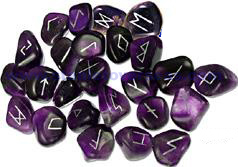| |
|
RUNES READER
|
 The runic alphabets are a set of related alphabets using letters known as runes to write various Germanic languages prior to the adoption of the Latin alphabet and for specialized purposes thereafter. The Scandinavian variants are also known as futhark (or fuþark, derived from their first six letters of the alphabet: F, U, Þ, A, R, and K); the Anglo-Saxon variant is futhorc (due to sound changes undergone in Old English by the same six letters). Runology is the study of the runic alphabets, runic inscriptions, rune stones, and their history. Runology forms a specialized branch of Germanic linguistics.
The runic alphabets are a set of related alphabets using letters known as runes to write various Germanic languages prior to the adoption of the Latin alphabet and for specialized purposes thereafter. The Scandinavian variants are also known as futhark (or fuþark, derived from their first six letters of the alphabet: F, U, Þ, A, R, and K); the Anglo-Saxon variant is futhorc (due to sound changes undergone in Old English by the same six letters). Runology is the study of the runic alphabets, runic inscriptions, rune stones, and their history. Runology forms a specialized branch of Germanic linguistics.
The earliest runic inscriptions date from around 150 AD, and the alphabet was generally replaced by the Latin alphabet along with Christianization by around 700 AD in central Europe and by around 1100 AD in Scandinavia; however, the use of runes persisted for specialized purposes in Scandinavia, longest in rural Sweden until the early twentieth century (used mainly for decoration as runes in Dalarna and on Runic calendars).
The three best-known runic alphabets are the Elder Futhark (around 150 to 800 AD), the Old English Futhorc (400 to 1100 AD), and the Younger Futhark (800–1100). The Younger Futhark is further divided into the long-branch runes (also called Danish, although they were also used in Norway and Sweden), short-twig or Rök runes (also called Swedish-Norwegian, although they were also used in Denmark), and the Hälsinge runes (staveless runes). The Younger Futhark developed further into the Marcomannic runes, the Medieval runes (1100 AD to 1500 AD), and the Dalecarlian runes (around 1500 to 1800 AD).
The origins of the runic alphabet are uncertain. Many characters of the Elder Futhark bear a close resemblance to characters from the Latin alphabet. Other candidates are the 5th to 1st century BC Northern Italic alphabets: Lepontic, Rhaetic and Venetic, all of which are closely related to each other and descend from the Old Italic alphabet.
History and usage
The runes were in use among the Germanic peoples from the 1st or 2nd century AD.This period corresponds to the late Common Germanic stage linguistically, with a continuum of dialects not yet clearly separated into the three branches of later centuries; North Germanic, West Germanic, and East Germanic.
No distinction is made in surviving runic inscriptions between long and short vowels, although such a distinction was certainly present phonologically in the spoken languages of the time. Similarly, there are no signs for labiovelars in the Elder Futhark (such signs were introduced in both the Anglo-Saxon futhorc and the Gothic alphabet as variants of p;
The name runes contrasts with Latin or Greek letters. It is attested on a 6th century Alamannic rune staff as runa, and possibly as runo on the 4th century Einang stone. The name is from a root run- (Gothic runa), meaning "secret" or "whisper".
Magical or divinatory use
Ivn stanza 157 of Hávamál, the runes are attributed with the power to bring that which is dead to life. In this stanza, Odin recounts a spell:
Þat kann ek it tolfta,
I know a twelfth one if I see,
ef ek sé á tré uppi
up in a tree,
váfa virgilná,:
a dangling corpse in a noose,
svá ek ríst ok í rúnum fák,
I can so carve and color the runes,
at sá gengr gumi
that the man walks
ok mælir við mik.[9]
And talks with me.[10]
The earliest runic inscriptions found on artifacts give the name of either the craftsman or the proprietor, or, sometimes, remain a linguistic mystery. Due to this, it is possible that the early runes were not so much used as a simple writing system, but rather as magical signs to be used for charms. Although some say the runes were used for divination, there is no direct evidence to suggest they were ever used in this way. The name rune itself, taken to mean "secret, something hidden", seems to indicate that knowledge of the runes was originally considered esoteric, or restricted to an elite. The 6th century Björketorp Rune stone warns in Proto-Norse using the word rune in both senses:
Haidzruno runu, falahak haidera, ginnarunaz. Arageu haeramalausz uti az. Weladaude, sa'z þat barutz. Uþarba spa.
I, master of the runes(?) conceal here runes of power. Incessantly (plagued by) maleficence, (doomed to) insidious death (is) he who breaks this (monument). I prophesy destruction / prophecy of destruction.
The same curse and use of the word rune is also found on the Stentoften Runestone. There are also some inscriptions suggesting a medieval belief in the magical significance of runes, such as the Franks Casket (700 AD) panel.
|
|
|